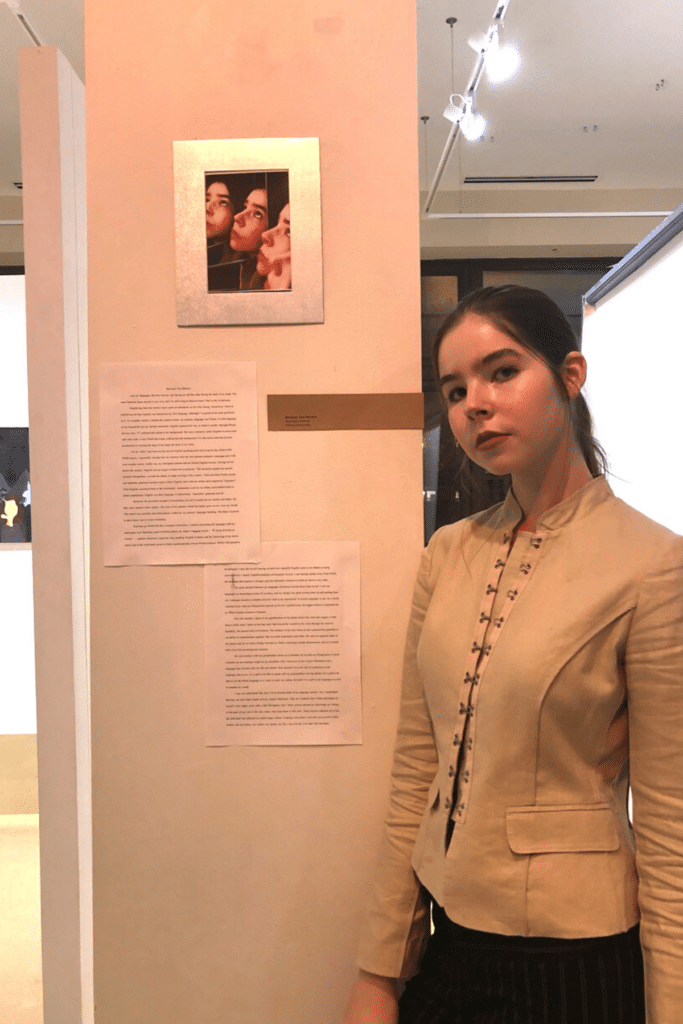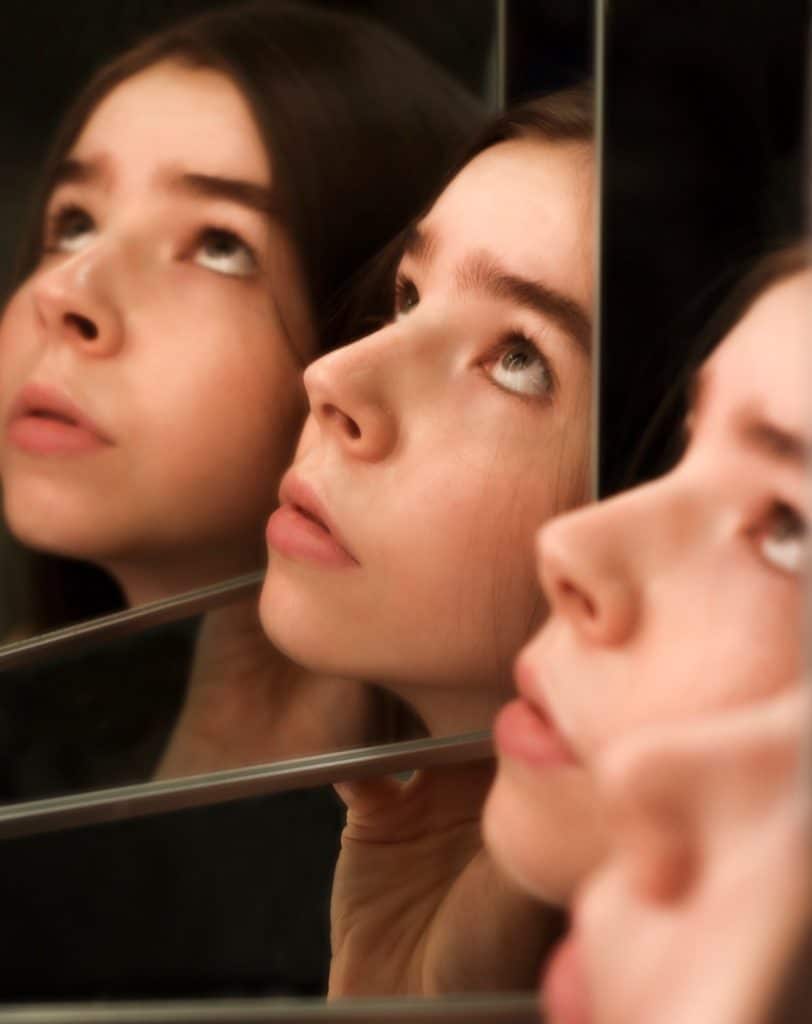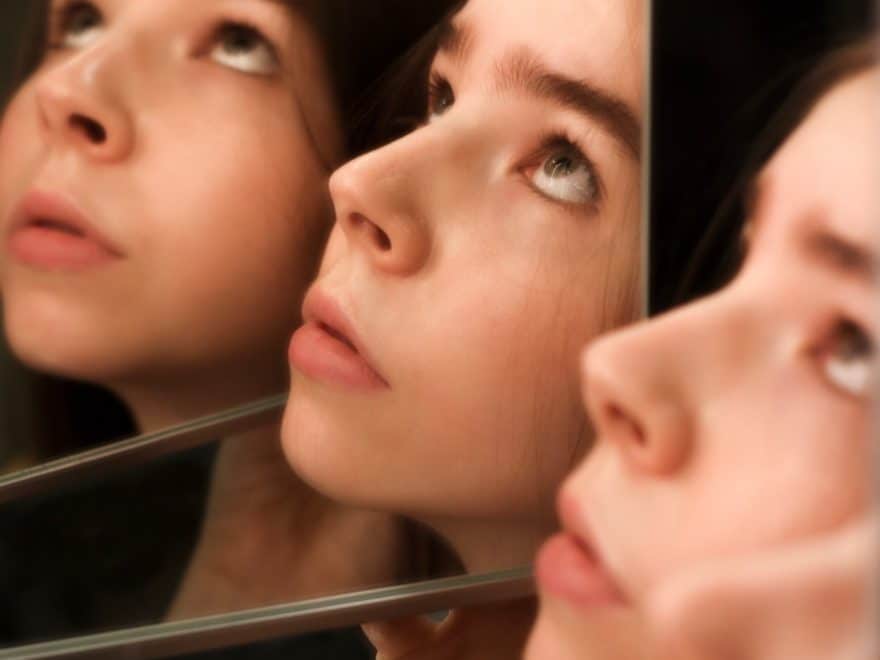WRD major Weronika Koleda shared her art and writing in a piece titled Between Two Mirrors at the KINETIC art gallery this quarter. Sponsored by Asian Americans Advancing Justice | Chicago and hosted at the Hairpin Arts Center, Weronika’s work was born from her multicultural and bilingual identity and her relationship with Polish and English.
This year’s KINETIC art gallery, “Re: Title – Alone Voices Fear To Belong, Alone Voices Together Are Strong,” showcased art and performances by “immigrant and refugee youth as a form of powerful storytelling to reclaim the narratives placed onto them and their families, and shift the narrative to show our power and build solidarity.”
Introduced to this exhibit through a fellow friend and artist, Weronika submitted a photograph in response to this year’s theme and her own experiences.
“I see my languages like two mirrors: One facing me and the other facing the back of my head. The space between these mirrors is my own, and I’m still trying to discover how I feel in this in between.”
We were lucky to catch up with Weronika following the gallery to learn more about her art and her experience with language. For Weronika’s full artist statement, click here.
How did you come to share your work and what inspired the piece Between Two Mirrors?
I had never displayed my work in such a public manner before, but I was eager to face my self doubts and self criticism by finally agreeing to get my writing out there. It was also a chance for me to get in touch with a part of my identity that I feel I have neglected for much of my adolescence and young adult life. To me, making use of this opportunity made sense because it put me on a path towards feeling more confident in displaying my writing and getting in touch with my Polish identity.
As for the piece itself, I was inspired to write it after completing a short essay for Jason Schneider’s Language, Self, and Society class. The essay asked us to write about the relationship between ourselves and the languages we use, so naturally, I dedicated a part of that essay to writing about how my English and Polish languages conflict and interact within my life. After completing that essay, I decided to elaborate more on these ideas in my piece that I ultimately submitted to KINECT.
Can you tell us a little bit about your art exhibit and how your experiences as a bilingual person inspired that art?

I ultimately tried to synthesize in my piece my feelings about the conflict between how I view and use English and Polish in my life, and how these languages ultimately shape my identity and my culture. For a major part of my life, I feel like I have placed Polish on the back burner while English became the language I more naturally gravitated to due to growing up in an English speaking community and receiving my education in English. Too often, Polish was an extra weight I had to carry, until I realized that the language represents my voice as the daughter of Polish immigrants.
I realize my Polish language carries not only my story, but the story of my family. It is how I stay grounded to my roots and how I can build relationships with my relatives. My voice as a bilingual speaker should carry my culture into my American community, and it should not be stuck in the back of my throat. I believe that at this point in my life, I feel like I must recognize how both of these languages make up who I am, but I should not let one overtake the other. Although it is a mindset and set of habits that will take time to unlearn, I strive to more actively recognize how my Polish identity carries the weight of my culture, traditions, and family.
What do you hope your art says to people? What questions do you hope it makes them ask or what things do you hope it helps them (re)consider?
I hope that my art shows people that they are not the only ones still trying to figure out their own bilingual or multicultural identity. I want to illustrate how not everyone is going to have an epiphany or completely understand how they sit with their own identity from an early age. In fact, many of us do not go on this personal journey until we hit adulthood, or this journey spans across several years of our lifetime. I’d like those who read my piece to ask the same questions that I asked myself before writing my piece: How have my languages contributed to how I view my identity and vise versa? Do I feel content with my current relationship with my culture? How can I grow and evolve my identity in the future? What should I learn to appreciate and be grateful for within my background?
In general, I hope I inspire others to dig deeper within themselves and ask questions about their identity they may have not actively thought of before. I want others to reflect upon how their culture, languages, and identities have impacted their lives and how their voices connect to a larger community they may not have found yet.
How have your experiences in the WRD program influenced your identity as an artist or the art you create?

At this point in time, I think my experiences and education that I received as a WRD student have enhanced my writing skills as a whole and allowed me to grow as a writer skill-wise. However, I believe that these experiences have acted more as tools that I can decide how to use in my writing. On the other hand, the WRD department has instilled class discussions that focus on multiculturalism or other aspects of identity (such as in Jason Schneider’s class I mentioned earlier) that create an outlet for my to think about aspects of my identity or bring them to the table.
While I don’t think the WRD department has chiefly molded my artistic identity, it has opened some doors for me to reflect upon areas of my personhood. In short, my experience in the WRD department has given me useful tools for being a writer and allowed me to acknowledge certain areas of my identity. Using these tools and reflection, I can motivate myself more to go down the path of actualizing my artistic identity.
Why should WRD majors pursue opportunities like this with their own writing or art beyond the program and university?
It’s important for WRD majors to get involved in their communities in one way or another. The skills we learn within the department are applicable to a wide variety of areas, and it is valuable to communicate them in areas that possess meaning to students. Wherever we decide to use our skills, we are able to find communities and connection with members of those communities. I assume that each and every one of us students within the department has something they want to say, a message they want to put out or contribute to. Because our department teaches us how to effectively deliver these messages, it only makes sense to take steps toward speaking for what you believe in. Becoming active outside the university opens a whole new world of how writing and artistic expression can connect us and contribute to communities. These are opportunities where we can work towards finding ourselves and making meaning of our own identities. This is how we can further gain autonomy over our craft and illustrate how we have grown as writers.
